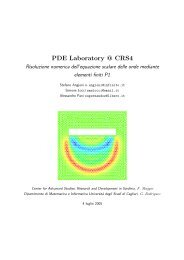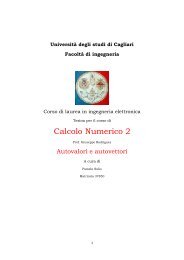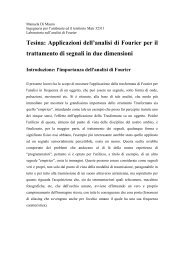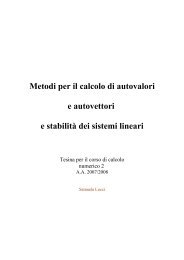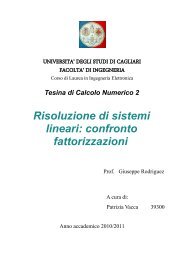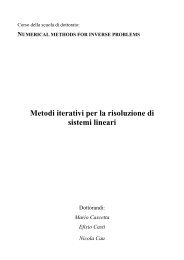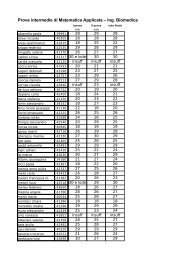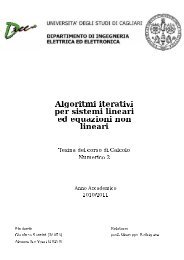TRASFORMATA DI FOURIER E LE FUNZIONI ARMONICHE
TRASFORMATA DI FOURIER E LE FUNZIONI ARMONICHE
TRASFORMATA DI FOURIER E LE FUNZIONI ARMONICHE
Create successful ePaper yourself
Turn your PDF publications into a flip-book with our unique Google optimized e-Paper software.
appartenente a S ′ , con f = F [g], e se F [f] = 0, si ha anche f = 0. Abbiamo,quindi, dimostrato che le trasformazioni di Fourier F e F −1 trasformano S ′in S ′ in modo biunivoco e continuo.Supponiamo che f = f(x, y) ∈ S ′ (R n+m ) dove x ∈ R n ed y ∈ R m .Introduciamo la trasformata di Fourier F x [f] rispetto alle variabili x =(x 1 , x 2 , · · · , x n ), ponendo per qualunque ϕ = ϕ(x, y) ∈ S(R n+m )(F x [f], ϕ) = (f, F ξ [ϕ]). (I.18)Come nel Lemma 3.1, si stabilisce che∫F ξ [ϕ](x, y) = ϕ(ξ, y)e i(ξ,x) dξ ∈ S(R n+m )e l’operazione F ξ [ϕ] è continua da S(R n+m ) in S(R n+m ), di modo che laformula (I.18) definisce realmente una funzione generalizzata F x [f](ξ, y) appartenentea S ′ (R n+m ).Esempio. Dimostriamo cheF [δ(x − x 0 )] = e i(ξ,x 0) .(I.19)Infatti,(F [δ(x − x 0 )], ϕ) = (δ(x − x 0 ), F [ϕ]) = F [ϕ](x 0 )∫= ϕ(ξ)e i(ξ,x0) dξ = (e i(ξ,x0) , ϕ), ϕ ∈ S.Ponendo nella (I.19) x 0 = 0, si ottieneda cuidi modo cheF [δ] = 1,δ = F −1 [1] = 1(2π) n F [1],F [1] = (2π) n δ(ξ).(I.20)(I.21)12





